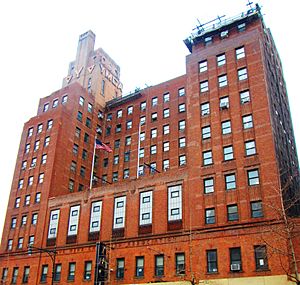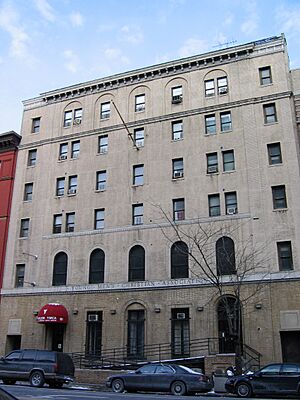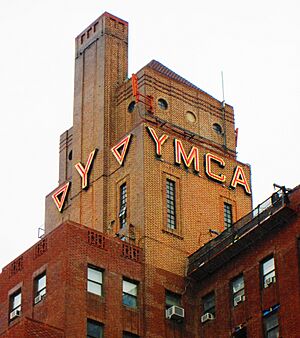Harlem YMCA facts for kids
|
Harlem YMCA
(Claude McKay Residence) |
|

(2014)
|
|
| Location | 180 West 135th Street Manhattan, New York City |
|---|---|
| Area | 9.9 acres (4.0 ha) |
| Built | 1931-32 |
| Architect | James C. Mackenzie Jr. (architect in charge) |
| NRHP reference No. | 76002143 |
Quick facts for kids Significant dates |
|
| Added to NRHP | December 8, 1976 |
| Designated NHL | December 8, 1976 |
The Harlem YMCA is an important building in New York City. It is located at 180 West 135th Street in the Harlem neighborhood of Manhattan. This building was constructed in 1931-32.
The YMCA was designed in a style called neo-Georgian. James C. Mackenzie Jr. was the main architect. Inside, you can see a famous mural by Aaron Douglas. It is called "Evolution of Negro Dance."
This building is very special. It was named a National Historic Landmark in 1976. Later, in 1998, it became a New York City Landmark.
Contents
Why the Harlem YMCA is Important
Around 1900, there was a YMCA for African Americans in New York City. It was located on West 53rd Street. This area was home to many African American families.
Between 1910 and 1930, Harlem changed a lot. It became the main center for New York's African American community. Many people moved there.
The First YMCA Building
The first YMCA building on West 135th Street opened in 1919. It cost $375,000 to build. Julius Rosenwald, who was the president of Sears, Roebuck and Company, helped pay for it.
This building had 226 rooms. It was designed by architect John Jackson. The YMCA quickly became a key place in the community. It was also important during the Harlem Renaissance. This was a time when African American art and culture grew.
The YMCA helped many people. This included writers, workers, and young black people looking for jobs. Soon, the building became too crowded. More space was needed for programs and advice.
A Home for Famous Visitors
The West 135th Street YMCA was a temporary home for many famous African American visitors. These people often could not stay in hotels in other parts of New York. This was because of unfair treatment based on race.
Many well-known people stayed there. These include writers like Richard Wright, Claude McKay, Ralph Ellison, and Langston Hughes. Artists such as Jacob Lawrence and Aaron Douglas also stayed there. Famous actors like Ossie Davis, Ruby Dee, Cicely Tyson, and Paul Robeson also found a place to stay.
In 1933, the current Harlem YMCA was built. It is right across the street from the first building. The original building was later used as an "annex." In 1996, it became the Harlem YMCA Jackie Robinson Youth Center. This first building also received New York City landmark status in 2016.
History of the Current Building
The Harlem YMCA was mainly for African American men. At the time, most YMCAs were only for white people. This YMCA was one of the best equipped in the United States.
The upper floors of the building were designed as homes. Many important people lived there. African-American author Maria Celeste lived in the building from 1941 to 1946.
Many famous black Americans have stayed at the Harlem YMCA. This includes Malcolm X, who stayed there because it was close to his favorite places. The building was named a National Historic Landmark in 1976. This was because of its connection to the writer Claude McKay. He was a major figure of the Harlem Renaissance. Claude McKay lived in the building from 1941 until 1946.






